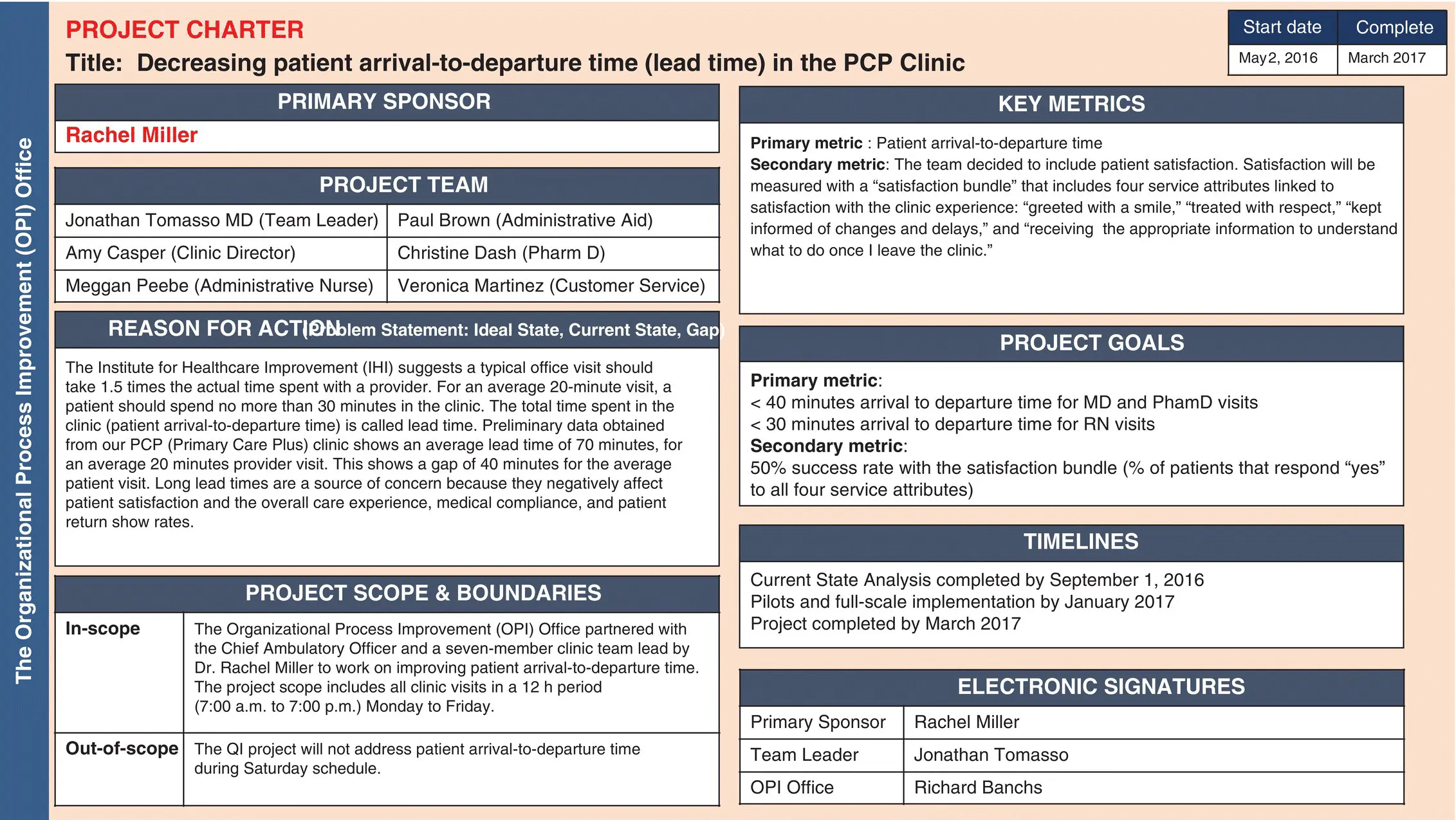The Project Charter is a valuable tool to provide direction to a QI team as well as to establish performance expectations of both the Project Sponsor and the QI team that senior leadership can use to track performance of all parties.
Example: The patient arrival‐to‐departure time at the PCP clinic
Figure 4‐1is an example of a Project Charter for you. The charter includes the Primary Sponsor, project team members, reason for action, project scope and boundaries, key metrics, goals of the project, timelines, and electronic signatures. We have created our own template, but, of course, you can build your own.

FIGURE 4‐1The patient arrival‐to‐departure time at the PCP clinic.
EXERCISE: A PROBLEM STATEMENT AND PROJECT CHARTER FOR YOUR QI PROJECT
Think of a problem you would like to address and the project you would launch. Using what you have learned so far
Write a short paragraph describing the problem you aim to address, reasons why you should address the problem, the consequences of not addressing the problem, and the “why now?” you are addressing the problem. Be careful not to include the causes of the problem or possible solutions in your problem statement.
Write your first draft of a Project Charter; make sure it has the six “must‐haves.” You will probably have to estimate the goals and timelines.
1 What are three common steps used when writing a problem statement?The ideal state, current state, and gapThe current state, ideal state, solutionsThe pain points, current state, solutionsThe root causes, solutions, current stateType A, type B, and type C
2 What is a Project Charter?An important document for every projectA definition of the scope and objectives of the projectA cooperative effort between the Primary Sponsor, the team leader, and the QI teamA living document that can be modified as more information becomes availableAll of the above
3 What are some of the critical elements for all Project Charters?Suppliers, inputs, processes, and outputsThe Voice of the Customer and the Voice of the StakeholderThe Problem Statement, scope, metrics, targets, and timelinesThe problem and the data to support the problemThe primary and supplemental sponsors
4 Once you create a Project Charter, it is “set in stone.”TrueFalse
5 What is a statement that defines the problem and the undesirable outcomes from the customer’s perspective?A need statementA Project CharterA SIPOC diagramA Problem StatementAn aim statement
6 Which of the following statements defines a well‐written Problem Statement?Is clear, precise, without unnecessary medical or technical jargonExplains the extent of the problemDescribes the problem at the level where the root cause is not yet knownProvides available supporting dataAll of the above
7 A “business case” includes all the following EXCEPTa brief explanation of the reasons to address the problem;the consequences of not addressing the problem;the causes of the problem;the link between the problem, the project, and the clinical priorities; orthe goals we want to achieve.
Key: 1a, 2e, 3c, 4b, 5d, 6e, 7c
PART III THE SECOND “R”: THE RIGHT PEOPLE
CHAPTER 5 Don’t Go at It Alone : Find a Primary Sponsor
STORIES FROM THE FRONT LINES OF HEALTHCARE: TURN‐AROUND TIME FOR X‐RAYS IN THE ED
Dr. Ashley Nixon was an Emergency Department (ED) physician at Mercy Hospital. She and her colleagues staffed the surgical care track of the ED. She took pride in her work and her ability to provide high‐quality, efficient care to her patients but was becoming increasingly concerned about the long turn‐around time for X‐rays. The time to get an X‐ray result once the order was in had more than doubled in the last six months. This was affecting patient flow and her ability to provide timely care for her patients. Dr. Nixon decided to launch a QI project to improve the situation. After evaluating the current process, she decided to make some changes she thought would improve turn‐around time for X‐rays. She discussed these changes with Dr. Edward Mosley, a colleague. He agreed that she had a good plan and that the changes would help expedite the turn‐around time for results. Dr. Nixon emailed the revised process to the ED nurse managers and the radiology manager, indicating they would start the revised process the following week. On Monday morning, Dr. Nixon met significant resistance. Nurses and radiology techs said they didn’t know anything about the revised process and would need their managers’ approval before proceeding with “doing anything differently.” When asked for advice, Dr. Mosley suggested to Dr. Nixon that she talk directly to the nurse and radiology manager. Over the ensuing months, several meetings were scheduled, but without the active involvement of a senior leader, no progress was made. Delays continued with X‐rays in the ED .
What was the problem? How did Dr. Nixon approach it? What was the result? Why did this happen?
THE PRIMARY SPONSOR
What Is a Primary Sponsor?
All projects need a sponsor. A Primary Sponsor can be a physician leader, departmental chair, division chief, executive leader, director, or high‐level unit manager.
A Primary Sponsor is the senior leader who has access to the necessary resources and the authority to ensure the success of the improvement project or change initiative.
As a senior leader in the organization, the Primary Sponsor can “ open doors” for the improvement team. The Primary Sponsor uses connections, influence, and a power base to increase buy‐in, resolve cross‐functional issues, and mitigate resistance from the frontline stakeholders.
The Critical Role of a Primary Sponsor
The role of the Primary Sponsor in the QI project is critical. The Primary Sponsor serves an essential function for the project team in helping move the project forward and achieve objectives. These are the most important functions of the Primary Sponsor:
Establish priorities for competing initiatives.
Resolve cross‐functional issues.
Remove roadblocks; the Primary Sponsor serves as the point person to address barriers that interfere with the project’s progression.
Help manage change by building a coalition of key stakeholders to support the change.
One of the most common causes of QI project failure is the absence or lack of meaningful involvement of the Primary Sponsor to provide the necessary leadership and support for the change initiative . The Primary Sponsor needs to be visible, engaged, and active throughout the lifecycle of the project.
The role of the Primary Sponsor is crucial in the team’s ability to manage change. Improvement teams often start a project without involving a senior leader and then struggle unnecessarily throughout the project. The Primary Sponsor is the project facilitator and the change leader. Ronald Heifetz, professor of leadership at the John F. Kennedy School of Government at Harvard University, defines the change leader as “the person that provides the technical solution while preparing people for the adaptive change by understanding their loss, providing hope, and explaining the process” (Heifetz 2002).
To appropriately fulfill the role, the Primary Sponsor must spend time communicating directly with the front lines to help the QI Team gain buy‐in for the project. One of the greatest contributors to success in change initiatives is an active and visible Primary Sponsor. The greatest obstacle to success is ineffective change management sponsorship to support the QI project (Prosci 2016).
Читать дальше













